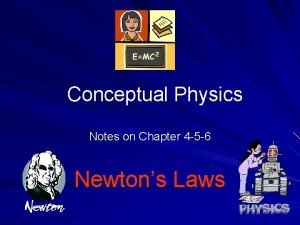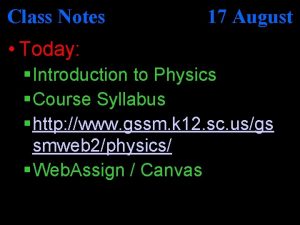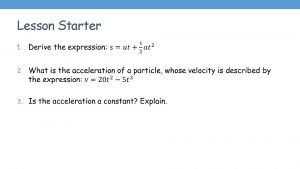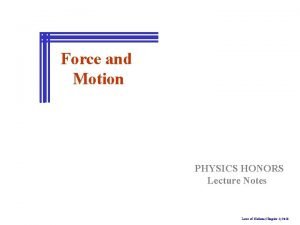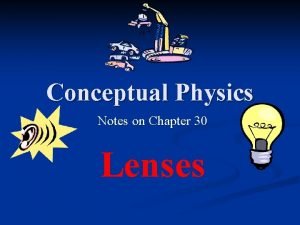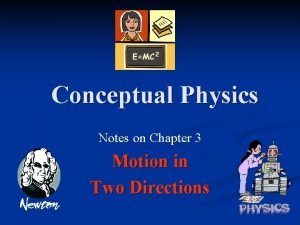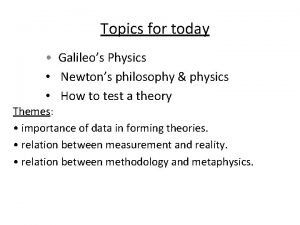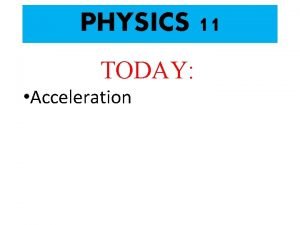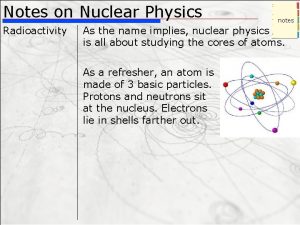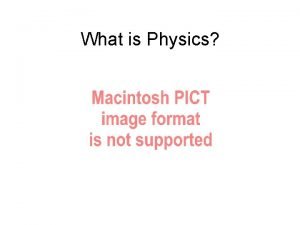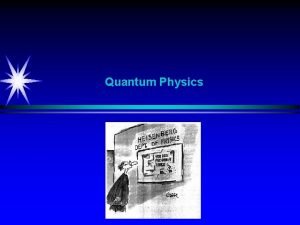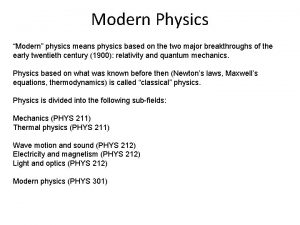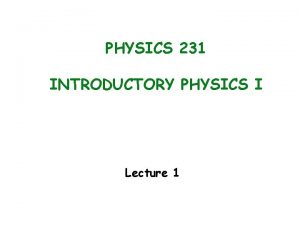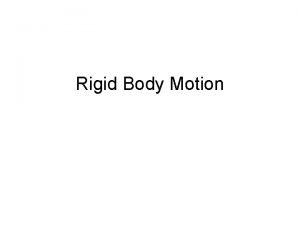Plan for Today AP Physics 2 Notes on













































- Slides: 45



Plan for Today (AP Physics 2) • Notes on Double Slit and Light

Diffraction of Light Diffraction is the ability of light waves to bend around obstacles placed in their path. Ocean Beach Light rays Fuzzy Shadow Water waves easily bend around obstacles, but light waves also bend, as evidenced by the lack of a sharp shadow on the wall.

Water Waves A wave generator sends periodic water waves into a barrier with a small gap, as shown below. A new set of waves is observed emerging from the gap to the wall.

Conditions for Interference • The sources must be coherent – They must be in phase with respect to each other • The waves must have identical wave lengths

Interference of Water Waves An interference pattern is set up by water waves leaving two slits at the same instant.

Videos • MIT • General Background

Young’s Experiment In Young’s experiment, light from a monochromatic source falls on two slits, setting up an interference pattern analogous to that with water waves. Light source S 1 S 2

The Superposition Principle • The resultant displacement of two simultaneous waves (blue and green) is the algebraic sum of the two displacements. • The composite wave is shown in yellow. Constructive Interference Destructive Interference The superposition of two coherent light waves results in light and dark fringes on a screen.

Young’s Interference Pattern s 1 Constructive Bright fringe s 2 s 1 Destructive Dark fringe s 2 Constructive Bright fringe

Conditions for Bright Fringes Bright fringes occur when the difference in path Dp is an integral multiple of one wave length l. p 1 p 2 l l l p 3 p 4 Path difference Bright fringes: Dp = 0, l , 2 l, 3 l, … Dp = ml, m = 0, 1, 2, . . .

Conditions for Dark Fringes Dark fringes occur when the difference in path Dp is an odd multiple of one-half of a wave length l/2. p 1 p 2 p 3 Dark fringes: l l n = odd n= 1, 3, 5 …

Alternate (Book) Definition of Dark Fringes • Dp = (m+ 1/2)l • M = 0, +/- 1, +/- 2. . .

Analytical Methods for Fringes x s 1 d q s 2 Path difference determines light and dark pattern. d sin q p 1 p 2 y Dp = p 1 – p 2 Dp = d sin q Bright fringes: d sin q = nl, n = 0, 1, 2, 3, . . . Dark fringes: d sin q = nl/2 , n = 1, 3, 5, . . .

Analytical Methods (Cont. ) s 1 d q s 2 From geometry, we recall that: x d sin q p 1 p 2 Bright fringes: y So that. . . Dark fringes:

Example 1: Two slits are 0. 08 mm apart, and the screen is 2 m away. How far is the third dark fringe located from the central maximum if light of wavelength 600 nm is used? x = 2 m; d = 0. 08 mm l = 600 nm; y = ? d sin q = 5(l/2) The third dark fringe occurs when n = 5 Dark fringes: x s 1 s 2 q d sin q n = 1, 3, 5 y

Example 1 (Cont. ): Two slits are 0. 08 mm apart, and the screen is 2 m away. How far is the third dark fringe located from the central maximum if l = 600 nm? x x = 2 m; d = 0. 08 mm s 1 d sin q l = 600 nm; y = ? q s 2 y n = 1, 3, 5 y = 3. 75 cm

The Diffraction Grating A diffraction grating consists of thousands of parallel slits etched on glass so that brighter and sharper patterns can be observed than with Young’s experiment. Equation is similar. d sin q = nl n = 1, 2, 3, …

The Grating Equation The grating equation: d = slit width (spacing) l = wavelength of light q = angular deviation n = order of fringe 3 l 2 l l 1 st order 6 l 4 l 2 l 2 nd order

Example 2: Light (600 nm) strikes a grating ruled with 300 lines/mm. What is the angular deviation of the 2 nd order bright fringe? To find slit separation, we take reciprocal of 300 lines/mm: Lines/mm mm/line n=2 300 lines/mm

Example (Cont. ) 2: A grating is ruled with 300 lines/mm. What is the angular deviation of the 2 nd order bright fringe? l = 600 nm n=2 300 lines/mm Angular deviation of second order fringe is: q 2 = 21. 10

Thin Films

Thin Films • Film thickness = t • Index of refraction = n • Light rays nearly normal to the surface

What occurs • 1. An electromagnetic wave undergoes a 180 degree phase change if it goes from a smaller n to a bigger n (n 2 > n 1). No phase change otherwise • 2.

Equation for Constructive Interference in Thin Films • 2 t = (m + ½) * hn, • M = 0, 1, 2. . . • Rewritten

Equation for Destructive Interference in a Thin Film

Picture of Situation

Equation Derivation

Pictures of What This Looks Like

A compact disk acts as a diffraction grating. The colors and intensity of the reflected light depend on the orientation of the disc relative to the eye.

Interference From Single Slit When monochromatic light strikes a single slit, diffraction from the edges produces an interference pattern as illustrated. Relative intensity Pattern Exaggerated The interference results from the fact that not all paths of light travel the same distance some arrive out of phase.

Single Slit Interference Pattern Each point inside slit acts as a source. For rays 1 and 3 and for 2 and 4: a/2 a a/2 1 2 3 4 5 First dark fringe: For every ray there is another ray that differs by this path and therefore interferes destructively.

Single Slit Interference Pattern First dark fringe: a/2 a a/2 1 2 3 4 5 Other dark fringes occur for integral multiples of this fraction l/a.

Example 3: Monochromatic light shines on a single slit of width 0. 45 mm. On a screen 1. 5 m away, the first dark fringe is displaced 2 mm from the central maximum. What is the wavelength of the light? l=? x = 1. 5 m q a = 0. 35 mm l = 600 nm y

Diffraction for a Circular Opening D Circular diffraction The diffraction of light passing through a circular opening produces circular interference fringes that often blur images. For optical instruments, the problem increases with larger diameters D.

Resolution of Images Consider light through a pinhole. As two objects get closer the interference fringes overlap, making it difficult to distinguish separate images. Clear image of each object d 1 Separate images barely seen d 2

Resolution Limit Images are just resolved when central maximum of one pattern coincides with first dark fringe of the other pattern. Separate images Resolution limit d 2 Resolution Limit

Resolving Power of Instruments The resolving power of an instrument is a measure of its ability to produce well-defined separate images. D q Limiting angle For small angles, sin q q, and the limiting angle of resolution for a circular opening is: Limiting angle of resolution:

Resolution and Distance p so q D q Limiting angle qo Limiting Angle of Resolution:

Example 4: The tail lights (l = 632 nm) of an auto are 1. 2 m apart and the pupil of the eye is around 2 mm in diameter. How far away can the tail lights be resolved as separate images? p so Tail lights q D q Eye p = 3. 11 km

Summary Young’s Experiment: Monochromatic light falls on two slits, producing interference fringes on a screen. Bright fringes: s 1 d q s 2 x d sin q p 1 p 2 Dark fringes: y

Summary (Cont. ) The grating equation: d = slit width (spacing) q = angular deviation l = wavelength of light n = order of fringe

Summary (Cont. ) Interference from a single slit of width a: Relative Intensity Pattern Exaggerated

Summary (cont. ) The resolving power of instruments. p so q D q Limiting angle qo Limiting Angle of Resolution:
 For today's meeting
For today's meeting There is class today
There is class today Meeting objective
Meeting objective Fingerprint ridge characteristics worksheet
Fingerprint ridge characteristics worksheet Today's lesson or today lesson
Today's lesson or today lesson Example of repitition
Example of repitition Wisc
Wisc Waves physics pdf
Waves physics pdf Classical mechanics
Classical mechanics Conceptual physics chapter 8
Conceptual physics chapter 8 What is a harmonic wave in physics
What is a harmonic wave in physics Conceptual physics notes
Conceptual physics notes Physics 101 lecture notes pdf
Physics 101 lecture notes pdf Scanything
Scanything Ap physics 2 notes
Ap physics 2 notes Advanced higher physics data sheet
Advanced higher physics data sheet Atmospheric physics lecture notes
Atmospheric physics lecture notes Physics honors notes
Physics honors notes Conceptual physics notes
Conceptual physics notes Conceptual physics notes
Conceptual physics notes Why does it happen
Why does it happen University physics with modern physics fifteenth edition
University physics with modern physics fifteenth edition Physics ia topic ideas
Physics ia topic ideas Kontinuitetshantering i praktiken
Kontinuitetshantering i praktiken Novell typiska drag
Novell typiska drag Nationell inriktning för artificiell intelligens
Nationell inriktning för artificiell intelligens Returpilarna
Returpilarna Varför kallas perioden 1918-1939 för mellankrigstiden?
Varför kallas perioden 1918-1939 för mellankrigstiden? En lathund för arbete med kontinuitetshantering
En lathund för arbete med kontinuitetshantering Kassaregister ideell förening
Kassaregister ideell förening Tidböcker
Tidböcker Sura för anatom
Sura för anatom Vad är densitet
Vad är densitet Datorkunskap för nybörjare
Datorkunskap för nybörjare Tack för att ni lyssnade bild
Tack för att ni lyssnade bild Debatt artikel mall
Debatt artikel mall Magnetsjukhus
Magnetsjukhus Nyckelkompetenser för livslångt lärande
Nyckelkompetenser för livslångt lärande Påbyggnader för flakfordon
Påbyggnader för flakfordon Lufttryck formel
Lufttryck formel Svenskt ramverk för digital samverkan
Svenskt ramverk för digital samverkan Bo bergman jag fryser om dina händer
Bo bergman jag fryser om dina händer Presentera för publik crossboss
Presentera för publik crossboss Argument för teckenspråk som minoritetsspråk
Argument för teckenspråk som minoritetsspråk Bat mitza
Bat mitza Klassificeringsstruktur för kommunala verksamheter
Klassificeringsstruktur för kommunala verksamheter











